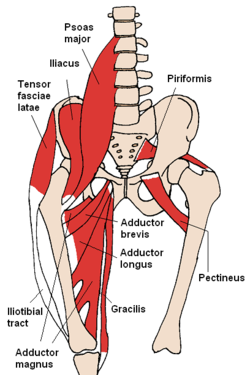Hip adductors
| Adductor muscles of the hip | |
|---|---|

The adductors and nearby muscles
|
|

Structures surrounding right hip-joint. (Adductor muscles visible at upper right.)
|
|
| Details | |
| Origin | Pubis |
| Insertion | Femur and tibia |
| Nerve | Obturator nerve |
| Actions | Adduction of hip |
|
Anatomical terms of muscle
[]
|
|
In human anatomy, the adductor muscles of the hip are a group of muscles of the thigh, mostly used for bringing the thighs together.
The adductor group is made up of:
The adductors originate on the pubis and ischium bones and insert mainly on the medial posterior surface of the femur.
The pectineus is the only adductor muscle that is innervated by the femoral nerve. The other adductor muscles are innervated by the obturator nerve with the exception of a small part of the adductor magnus which is innervated by the tibial nerve.
In 33% of people a supernumerary muscle is found between the adductor brevis and adductor minimus. When present, this muscle originates from the upper part of the inferior ramus of the pubis from where it runs downwards and laterally. In half of cases, it inserts into the anterior surface of the insertion aponeurosis of the adductor minimus. In the remaining cases, it is either inserted into the upper part of the pectineal line or the posterior part of the lesser trochanter. While similar to its neighbouring adductors, it is formed by separation from the superficial layer of the obturator externus, and is thus not ontogenetically related to the adductors.
So called adductor tenotomy (cutting the origin tendons of the adductor muscles of the thigh) and obturator neurectomy (cutting the anterior branch of the obturator nerve) is sometimes performed on children with cerebral palsy. These children often have hypertonia of the adductor muscles, making abduction difficult, obstructing normal hip development, and putting them at risk of hip luxation.
...
Wikipedia
